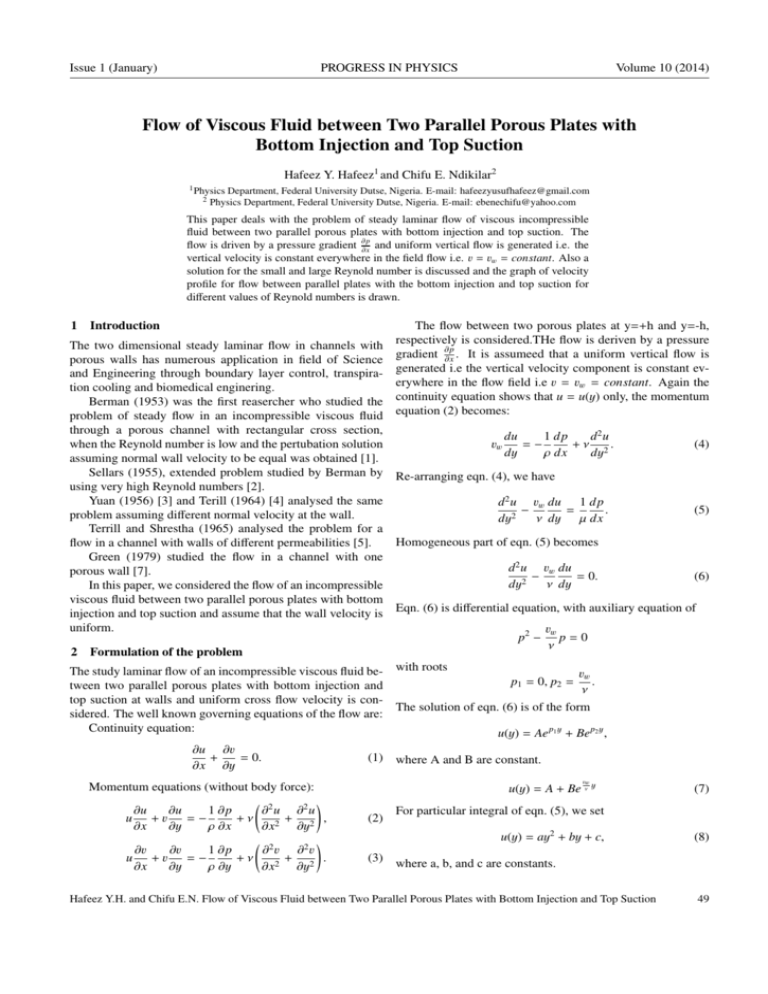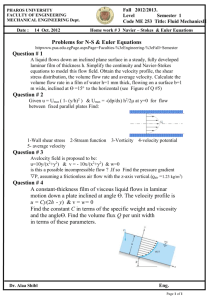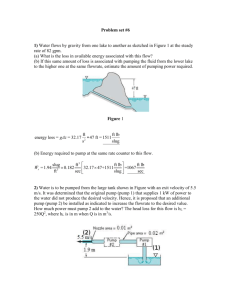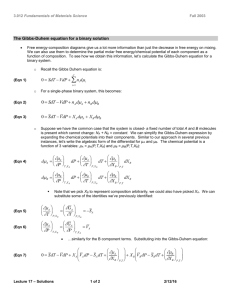Flow of Viscous Fluid between Two Parallel Porous Plates with
advertisement

Issue 1 (January) PROGRESS IN PHYSICS Volume 10 (2014) Flow of Viscous Fluid between Two Parallel Porous Plates with Bottom Injection and Top Suction Hafeez Y. Hafeez1 and Chifu E. Ndikilar2 1 Physics 2 Department, Federal University Dutse, Nigeria. E-mail: hafeezyusufhafeez@gmail.com Physics Department, Federal University Dutse, Nigeria. E-mail: ebenechifu@yahoo.com This paper deals with the problem of steady laminar flow of viscous incompressible fluid between two parallel porous plates with bottom injection and top suction. The and uniform vertical flow is generated i.e. the flow is driven by a pressure gradient ∂p ∂x vertical velocity is constant everywhere in the field flow i.e. v = vw = constant. Also a solution for the small and large Reynold number is discussed and the graph of velocity profile for flow between parallel plates with the bottom injection and top suction for different values of Reynold numbers is drawn. The flow between two porous plates at y=+h and y=-h, respectively is considered.THe flow is deriven by a pressure gradient ∂p ∂x . It is assumeed that a uniform vertical flow is generated i.e the vertical velocity component is constant everywhere in the flow field i.e v = vw = constant. Again the continuity equation shows that u = u(y) only, the momentum equation (2) becomes: 1 Introduction The two dimensional steady laminar flow in channels with porous walls has numerous application in field of Science and Engineering through boundary layer control, transpiration cooling and biomedical enginering. Berman (1953) was the first reasercher who studied the problem of steady flow in an incompressible viscous fluid through a porous channel with rectangular cross section, du 1 dp d2 u when the Reynold number is low and the pertubation solution vw =− +ν 2. (4) dy ρ dx dy assuming normal wall velocity to be equal was obtained [1]. Sellars (1955), extended problem studied by Berman by Re-arranging eqn. (4), we have using very high Reynold numbers [2]. Yuan (1956) [3] and Terill (1964) [4] analysed the same d2 u vw du 1 d p − (5) = . problem assuming different normal velocity at the wall. ν dy µ dx dy2 Terrill and Shrestha (1965) analysed the problem for a Homogeneous part of eqn. (5) becomes flow in a channel with walls of different permeabilities [5]. Green (1979) studied the flow in a channel with one d2 u vw du porous wall [7]. − = 0. (6) ν dy dy2 In this paper, we considered the flow of an incompressible viscous fluid between two parallel porous plates with bottom injection and top suction and assume that the wall velocity is Eqn. (6) is differential equation, with auxiliary equation of uniform. vw p2 − p = 0 ν 2 Formulation of the problem The study laminar flow of an incompressible viscous fluid be- with roots vw p1 = 0, p2 = . tween two parallel porous plates with bottom injection and ν top suction at walls and uniform cross flow velocity is conThe solution of eqn. (6) is of the form sidered. The well known governing equations of the flow are: Continuity equation: u(y) = Ae p1 y + Be p2 y , ∂u ∂v + = 0. ∂x ∂y Momentum equations (without body force): ( 2 ) ∂u ∂u 1 ∂p ∂ u ∂2 u u +v =− +ν , + ∂x ∂y ρ ∂x ∂x2 ∂y2 ( 2 ) ∂v 1 ∂p ∂ v ∂2 v ∂v =− +ν . u +v + ∂x ∂y ρ ∂y ∂x2 ∂y2 (1) where A and B are constant. vw u(y) = A + Be ν y (2) For particular integral of eqn. (5), we set u(y) = ay2 + by + c, (3) (7) (8) where a, b, and c are constants. Hafeez Y.H. and Chifu E.N. Flow of Viscous Fluid between Two Parallel Porous Plates with Bottom Injection and Top Suction 49 Volume 10 (2014) PROGRESS IN PHYSICS du d2 u = 2ay + b, ⇒ 2 = 2a dy dy (9) Substituting eqn. (9) in eqn. (5) we get ( vw ) vw 1 dp 2a − b − 2a y = . ν ν µ dx Comparing the co-efficients, we get a=0⇒b=− ν 1 dp . vw µ dx Now, eqn. (8) becomes u(y) = − ν 1 dp y + c. vw µ dx Issue 1 (January) The final solution of eqn. (5), y u(y) 2 y eRe − eRe h − 1 + . = umax Re h sinh Re (19) 2 h Where umax = 2µ (− ddyp ) is the centerline velocity for imporous or poiseuille. For very small Re (or small vertical velocity), then the last terms in the parentheses of of eqn. (19) can be expanded in a power series and sinh Re ≈ Re i.e. ( ) (10) y (Re)2 y2 (Re)2 1+Re+ + ..− 1+Re + +.. 2 h 2 h2 u(y) 2 y , = −1+ umax Re h Re (11) The final solution formes by adding eqn. (7) and eqn. (11) ( Re 1+ u(y) 2 y − 1 + = umax Re h Re 2 − Re y h − Re y2 2 h2 ) , u(y) y2 = 1 − . (20) (12) u(y) = D + Be umax h2 Eqn. (20) shows that, the poiseuille solution recovered. Since vw is constant, the equation is linear. We retain the For very large Re (or large vertical velocity), eqn. (19) no-slip condition for the main flow. can be written as y u(y) 2 y eRe − eRe h u(+h) = u(−h) = 0 = − 1 + 2 Re , umax Re h e − e−Re y vw u(y) 2 y 1 − e−Re(1− h ) h ν 1 dp = − 1 + 2 . u(h) = D + Be ν − (13) h umax Re h 1 − e−2Re vw µ dx For Re → ∞ and hy > 1, except for y = +h, we get vw − h ν 1 dp ] u(y) 2 [y u(−h) = D + Be ν + h. (14) = − 1 + 2 , vw µ dx u Re h vw ν y ν 1 dp − y. vw µ dx max Subtracting eqn. (14) from eqn. (13), we get ν h dp 2 vνw µh ddxp vw µ dx ( )= ( ). B = vw = vw e ν h − e− ν h 2 sinh vνw h sinh vνw h 2 vνw µh ddxp Substituting eqn. (15) into eqn. (13), we get u(y) 2 [ y] = 1+ , (21) umax Re h (15) so that a straight line variation which suddenly drops to zero at the upper wall. 3 Discussion The velocity profiles have been drawn for different values of Fig. (1), its ob(16) Reynold numbers (i.e. Re = 0, 3, 5, 10). From served that for Re ≥ 0 in the region −1 ≤ y∗ ≤ 1, the shapes change smoothly with Reynold numbers and the average veEqn. (12) reduces to locity is decreasing and Reynold number increases; i.e. the friction factor increases as we apply more cross flow through vw vw d p d p ν h ν h y ν h ν h d p vw µ dx e ν ν y dp vw µ dx e ( )+ ( )− + . (17) the wall. u(y) = − vw µ dx sinh vw h vw µ dx sinh vνw h ν 4 Conclussion ν h d p vνw h vw µ dx e ν h dp (v ) + . D=− w vw µ dx sinh ν h vw h ν In the above analysis a class of solution of flow of viscous But wall Reynold number is Re = vνw h, Re h = ν ⇒ Re = vw . fluid between two parallel porous plates with bottom injection Re-arranging eqn. (17), we get and top suction is presented when a cross flow velocity along y the boundary is uniform, the convective acceleration is linear h2 1 d p y eRe − eRe h . u(y) = − (18) − 1 + and the flow is deriven from pressure gradient. Re µ dx h sinh(Re) 50 Hafeez Y.H. and Chifu E.N. Flow of Viscous Fluid between Two Parallel Porous Plates with Bottom Injection and Top Suction Issue 1 (January) PROGRESS IN PHYSICS Volume 10 (2014) 4. Terrill R.M. Homotopy Analysis Solutions for the Asymmetric Laminar Flow in a Porous Channel with Expanding or Contracting Walls. Aeronautical Quarterly, 1964, v. 15, 299–310. 5. Terrill R.M., Shrestha G.M. Journal of Applied Mathematical Physics, 1965, v. 16, 470–482. 6. White F. Viscous fluid flow. 2nd edition, Mc Graw-Hill company, New York, 1991. 7. Green G.A. Laminar flow through a channel with one porous wall. Course project in Advanced fluid mechanics, 1979, Department of Chemical and Environmental Engineering. Fig. 1: Velocity profiles for flow between parallel plates with bottom injection and top suction for different values of Re. Nomenclature A,B,C,D: Constants h: Height of the channel P: Pressure x: Axial distance y:Lateral distance vw : Lateral wall velocity u(x,y): Axial velocity component v(x,y): Lateral velocity component y∗ = hy : Dimensionless lateral distance Re = vwνh : Wall Reynold number Greek Symbols µ: Shear viscosity ν: Kinematic viscosity ρ: Fluid density Submitted on January 20, 2014 / Accepted on January 25, 2014 References 1. Berman A.S. Laminar flow in channels with porous walls. Journal of Applied Physics, 1953, v. 24, 1232. 2. Sellars J.R. Laminar flow in channels with porous walls at high suction Reynold number. Journal of Applied Physics, 1955, v. 26, 489. 3. Yuan S.W. Further Investigation of Laminar Flow in Channels with Porous Walls. Journal of Applied Physics, 1956, v. 27(3), 267–269. Hafeez Y.H. and Chifu E.N. Flow of Viscous Fluid between Two Parallel Porous Plates with Bottom Injection and Top Suction 51





